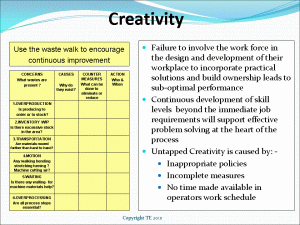The waste of Talent or creativity
The waste of Talent, creativity or your people is an addition to the seven wastes of lean manufacturing (Muda), it is the failure to make good use of your employees; all of them. Your employees are your most valuable resources when it comes to ensuring that the business runs smoothly and continuously improves.
Without the involvement and loyalty of all of your employees your company will fail to compete as effectively as it could do with their help. In today’s global marketplace we need every advantage that we can get to maintain and improve our businesses.
The Costs of the waste of Talent and creativity
The main cost of the waste of talent within your organization is in time wasted to make improvements and meet changing customer requirements. You will be far slower at making improvements and solving problems if you rely only on your “experts” to come up with the ideas, whilst your engineers, supervisors and managers may be highly skilled they are small in number compared to your other employees.
This failure to make improvements at a good pace will eventually mean that your competitors will move ahead of you and will lead the way within your industry whilst you lag far behind. They will win the business from you as they are able to offer enhanced service and lower costs.
Causes of the Waste of Talent and creativity.
Your peoples creativity and talent is wasted due to a number or reasons, having the wrong culture that fails to recognize the strengths and contribution of your employees is the main one. Many companies are just not “that type” of company, they have managers that manage and employees that follow instructions.
Even when companies try to recognize their employees contribution they often fail to provide sufficient time and resources to enable them to meet and make improvements. The company policies are often inappropriate and stifle improvements due to excess bureaucracy and measures that encourage the wrong types of behavior.
There is also a fear in some companies that if their operators are “over trained” and “too involved” they will expect higher wages and eventually leave and give the benefit to other companies.
Examples of wastes of Talent and creativity
Problem solving conducted only by experts, ignoring the input from other employees.
Improvement ideas that are forced upon different sections of the company rather than invented within them.
A workforce that feels that there is no point in making suggestions for improvement.
How to eliminate or reduce the waste of Talent
Team working, training, and clear leadership are required to begin to involve all of your employees with your companies drive towards perfection, for continuous improvement you will need to involve each and every one of your employees.
Measures and compensation packages should reflect the need for people to work together to improve the company.
Encourage people to take ownership of their areas, processes, and products to promote a sense of pride and involvement.
Your people are your biggest asset, respect them, nurture them and involve them in your business and you will reap the rewards.
Improving Profit through Waste Reduction
By a process of reducing the causes of muda, muri amd mura in your organisation using lean principles you can begin to reduce the costs associated with these wastes and reap the benefits of lean manufacturing. Your people are your greatest asset on this journey of improvement and it is they who can help you eliminate the other wastes.
- A program of stock reduction; raw materials, work in progress and finished goods to eliminate the waste of Inventory.
- Reduce waiting for materials, instructions and information to eliminate the waste of waiting.
- Create Ergonomic work spaces to eliminate excessive movements and reduce the waste of motion.
- Introduce just in time principles to make what the customer wants when they want it to eliminate the waste of overproduction.
- Only do what is required by the customer rather than indulge the waste of overprocessing.
- Prevent errors in product and service to eliminate the waste of defects.
- Conserve your natural resources by not overusing gas, electricity and water and reduce the waste of resources.
- Prevent the transportation of goods from one location to another to prevent the waste of transport.

